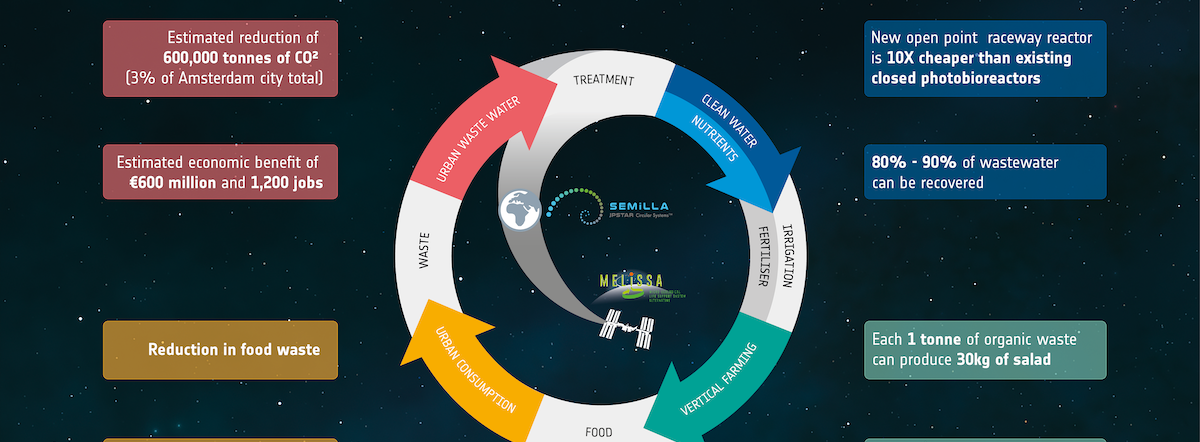Already today, cities consume 75% of the natural resources, produce 50% of the global waste, and emit 60-80% of the greenhouse gases (GHG). By 2050, two thirds of the population will live in cities around the world. Resource circularity could be a game-changing technology in helping to tackle these growing environmental challenges. The application of circular systems in cities can also bring about a number of social and economic benefits, including sustainable water supply, increased and healthier food production, and greener cities.

Amsterdam’s living labs initiative provides a testbed for developing new solutions, including SEMiLLA’s IPStar Circular System at the recently opened Marineterrein lab, which helps the city of Amsterdam quickly adopt new technologies to enable the city to reach the goal of becoming a fully circular city by 2050.
Space technology brought down to Earth
Developed for space exploration and further supported by ESA’s Technology Transfer Programme, ESA’s support allows SEMiLLA IPStar, MELiSSA technology transfer partner to optimize the space technologies for terrestrial applications. MELiSSA (Micro-Ecological Life Support System Alternative) is a European project running for more than 30 years within the ESA, bringing many research institutes and organisations together to develop circular life support systems for the ISS and beyond.
Through MELiSSA, organic and ceramic membranes were developed to filter astronauts’ wastewater, removing unwanted compounds, including nitrates. Furthermore, the project has been successful in using micro-organisms to process the waste to grow plants and food. Whilst work continues to increase the system efficiency towards 100% (a self-sustainable ecosystem that does not require resupply) for post-ISS habitats beyond Earth orbit, attention in recent years has turned to exploring how this technology can be adopted to benefit life on Earth. SEMiLLA applies MELiSSA technologies to Earth-based needs, including water treatment, waste management and recycling. SEMiLLA hope to provide an integrated waste management system to support the lifestyle of city inhabitants.
Turning waste into resource
SEMiLLA identified a number of potential applications for using MELiSSA technology for Earth applications from an initial feasibility study. Purple Phototrophic Bacteria (PPB) was chosen for development as Proof of Concept. In nature, PPB proliferate in anaerobic lagoon and ponds and many other stagnant water environments. PPB was chosen because of their peculiar biomass composition, typically rich in protein and other chemical compounds such as carotenoids and quinones. The project successfully demonstrated the use of the PPB raceway reactor (used for in the cultivation of algae) for purple bacteria cultivation on brewery and municipal yellow wastewater (urine). The project to date has focused on two key areas: nutrient recovery and water treatment, using the C-II MELiSSA technology to help cities transition to a circular economy, developed by SEMiLLA through the Proof of Concept (PoC) process.
Enabling SEMiLLA to develop circular systems for Earth
There are several socio-economic benefits that have already been realised in the initial stages of the technology development, with promise of many larger, global benefits to come as the SEMiLLA IPStar Circular System is scaled and becomes available to a wide range of users, from cities and utilities companies responsible for waste management, to buildings and companies seeking to reduce waste and lower energy costs.
Providing a range of health and social benefits
- TGROWx can produce 1 tonne of salad per 1m² per year.
- The feasibility study for the GreenTower in Amsterdam estimated the waste from the building could create an output of 276 to 575 kg of dried biomass per year. This quantity controlled for the 100% nitrogen requirement would result in 377 to 785 tons of lettuce produced per year.
Cities will become better places to live with the transition to a circular economy, with benefits ranging from cleaner streets, better air and water quality, and reduced risk of foodborne diseases. There is a great opportunity for SEMiLLA to create a new product and commercial service that can be provided on the market to a global userbase. The raceway reactor is being developed to be sold as a standalone unit and the near-term goal is to develop a fully-fledged wastewater and nutrient recovery system, provided as a service.
Delivering economic benefits
- The Ellen MacArthur Foundation estimates an economic benefit for the city of Amsterdam of €600 million.
- The Amsterdam Circular Roadmap estimates that high-quality recycling of organic residual streams, over a period of the next 5-7 years, can result in an added economic value for the municipality of €150 million per year.
- The Amsterdam Circular Roadmap estimates the creation of over 1,200 jobs in the city of Amsterdam.
Recycling waste helps to simultaneously solve energy and climate challenges. Circular vertical farms are carbon-negative as they take CO2 out of the air to feed plants. The process of recycling wastewater leads to a sustainable power source as energy comes from the anaerobic digestion of waste in the form of biogas – the GROWx circular system uses much less energy compared to a traditional vertical farm because of this process.
Protecting the environment
- The metropolitan area of Amsterdam currently imports 3.9 million tonnes of biomass. Replacing some of the imported mass with recovered biomass from waste would result in an estimated reduction of 600,000 tonnes of CO2 – 3% of the total CO2 emissions of the city.
- A collaboration between FABRIC, Circular Economy and TNO estimates a direct value creation from the project of €30 million, with a CO2 emissions reduction of 300 kilo-tonnes.

Cities of the Future
As cities embrace the circular economy model in an effort to be more sustainable, space technology applied to these terrestrial challenges can aid cities by providing resilient circular solutions and delivering significant socio-economic benefits. Resource circularity could be a game-changing technology in helping to tackle these growing environmental challenges. The application of circular systems in cities can also bring about a number of social and economic benefits, including sustainable water supply, increased and healthier food production, and greener cities.







